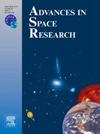Feasibility of orbital capture of near-earth asteroids based on the planar-circular restricted three-body problem
IF 2.8
3区 地球科学
Q2 ASTRONOMY & ASTROPHYSICS
引用次数: 0
Abstract
With the goal of efficiently extracting samples or even materials from the surface of an asteroid, this study proposed and investigated a method to change the velocity vector of a near-Earth asteroid and place it into an orbit where it is captured by the Earth’s gravitational field. The change in the orbit of an asteroid is not directly discussed in relation to the change in the velocity vector but is indirectly considered by the change in the Jacobi integral, which is the first integral of the circular-planar restricted three-body problem. In addition, the distribution of the smaller alignment index (SALI) is investigated to find a capture point where the asteroid is not put into a chaotic orbit. The proposed method is numerically demonstrated for fictional asteroid capture missions. The results show that several asteroids can be put into stable captured orbits. Additionally, we propose a method to optimize the value of the Jacobi integral, aiming to stabilize periodic captured orbits. Numerical integration confirms that when the Jacobi integral is optimized, the orbital lifetime of the captured orbit exceeds 500 years.
基于平面-圆形受限三体问题的近地小行星轨道捕获可行性研究
为了有效地从小行星表面提取样本甚至材料,本研究提出并研究了一种改变近地小行星的速度矢量并将其放置在被地球引力场捕获的轨道上的方法。小行星轨道的变化不直接与速度矢量的变化联系起来讨论,而是通过雅可比积分的变化间接地考虑,雅可比积分是圆平面限制三体问题的第一个积分。此外,研究了较小对准指数(SALI)的分布,以寻找小行星不进入混沌轨道的捕获点。该方法在虚拟小行星捕获任务中进行了数值验证。结果表明,一些小行星可以进入稳定的捕获轨道。此外,我们提出了一种优化雅可比积分值的方法,旨在稳定周期性捕获轨道。数值积分证实,当Jacobi积分优化时,捕获轨道的轨道寿命超过500年。
本文章由计算机程序翻译,如有差异,请以英文原文为准。
求助全文
约1分钟内获得全文
求助全文
来源期刊

Advances in Space Research
地学天文-地球科学综合
CiteScore
5.20
自引率
11.50%
发文量
800
审稿时长
5.8 months
期刊介绍:
The COSPAR publication Advances in Space Research (ASR) is an open journal covering all areas of space research including: space studies of the Earth''s surface, meteorology, climate, the Earth-Moon system, planets and small bodies of the solar system, upper atmospheres, ionospheres and magnetospheres of the Earth and planets including reference atmospheres, space plasmas in the solar system, astrophysics from space, materials sciences in space, fundamental physics in space, space debris, space weather, Earth observations of space phenomena, etc.
NB: Please note that manuscripts related to life sciences as related to space are no more accepted for submission to Advances in Space Research. Such manuscripts should now be submitted to the new COSPAR Journal Life Sciences in Space Research (LSSR).
All submissions are reviewed by two scientists in the field. COSPAR is an interdisciplinary scientific organization concerned with the progress of space research on an international scale. Operating under the rules of ICSU, COSPAR ignores political considerations and considers all questions solely from the scientific viewpoint.
 求助内容:
求助内容: 应助结果提醒方式:
应助结果提醒方式:


